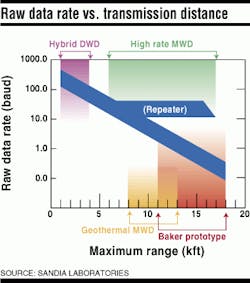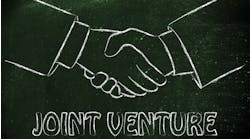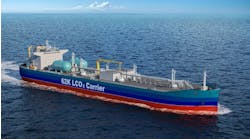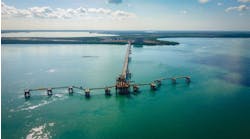Technology advances and new industry "buzz" words always go hand-in-hand. One of the more recent words circulating around the oil and gas industry, is "knowledge management." This phase is rapidly becoming a major topic of discussion among upper level, business development, operating, and IT managers around the industry. Unfortunately, like trickle-down economics, knowledge management seems to be all too slowly trickling down to the people charged with the day-to-day operations of the industry.
This shortage of information has created some confusion, and, as is usually the case with new topics and concepts, appears to be "all things, to all people." Conversations with at least five individuals from different sectors of the upstream oil and gas industry resulted in five different ideas on what knowledge management is.
- To a drilling field "hand", knowledge management is the transfer of know-how from a more experienced employee to a subordinate, normally achieved by word of mouth and on the job training.
- To an operations manager, it is empowering employees with the tools to efficiently perform their responsibilities.
- To an independent, it is a separate job function, retaining its own management staff and support infrastructure to achieve respective "knowledge management" goals and objectives.
- To others, it is simply putting the best person into the right position, at the right time - a practice often used within the oil business.
The largest industry-wide method of know ledge transfer at present has occurred every 5-7 years, coinciding with each downturn in the industry. A re-shuffling of technical and engineering personnel in the industry due to layoffs, and re-hiring, seems to give the industry an unwanted, yet unavoidable, transfer of knowledge.
What is knowledge management? Andrew Gould, Executive Vice President of Schlumberger Oilfield Services indicated in a February 1999 presentation entitled "Merging Knowledge and Technology to Improve Oilfield Efficiency," that knowledge management focuses on people - not technology. "It improves organizational efficiency and productivity through the collective ability of people to capture, share, and use experience and know-how effectively."
This brings up the issue of shifting the industry from building technologies, to acquiring data effectively, and from building infrastructures to better managing the massive amount of data the industry has become so efficient at gathering. In less than a decade the industry has gone from talking about kilobytes to petabytes of data - an exponential increase in the amount of information dealt with every day.
Independent consulting firms are aggressively developing an infrastructure to more quickly evolve this unique management function - a new trend. There is some irony with this trend. Knowledge in the petroleum industry has always been considered crucial to the competitive advantage of its participants. The ability to effectively retain technology secrets leads to competitive leverage.
Securing the knowledge learned from this diverse operational experience is key to building and maintaining competitive advantage. These companies have always gone to extremes to retain learned knowledge within their respective corporate walls. Independent consulting firms are offering services as a secured access conduit, through which information can traverse more efficiently between seller and buyer. These conduits, administered by the independent consulting firms, offer an alternative secure means of information transfer to service and operating companies.
Acoustic telemetry gaining efficiency
Move over, mud pulse telemetry. Recent gains in acoustic telemetry techniques are showing promising results. The advances are now being applied in the completion/pro duction business, with ongoing research and development work focusing on a while-drilling application.
A 1986 patent by Sandia Laboratories for acoustic telemetry via pipe tubulars was licensed by Baker Hughes Inteq two years ago. Further development by BHI resulted in the Baker prototype tool for use in completion/pro duction realtime monitoring applications. It collects downhole information and transmits through the production casing via acoustic telemetry, greatly enhancing intelligent completion technologies already in development.
Cameron has also experimented with acoustic telemetry and developed what it calls CamSmart™. Cameron obtained a patent in 1989 for application of acoustic signals via the drillpipe, from a tool in the wellhead. Today, it is the only alternative available for confirming proper seating of seal assemblies (beyond pressure testing), and downhole monitoring of casing running and cementing operations.
Operating cost is relatively expensive, but as the overall cost and risk of well projects increase, the need to know more about what's going on in the wellhead grows, and application of this technology is financially justified.
For example, if you could know immediately that a casing string had not landed properly in the wellhead, corrective measures could be taken to eliminate expensive remediation operations. As is sometimes the case, the casing and tubing hangars are from different vendors. This technology allows a "comfort factor" in the compatability of the two different tools.
Prematurely setting of seal assemblies has been a problem in the past with operators over-anxious to get the string set and cemented. This can be averted with this technology, as it provides added confidence and "insurance" that proper sealing has occurred.
The tool operates on batteries, giving the equipment a known life expectancy. It is designed for a few transmissions in a short-term job situation (eight hours to eight days). Batteries can be recharged at the surface if "safe areas" are available on the rig. Batteries are rated to 150°C. This is sufficient as the wellhead tool never goes below the seafloor.
Sandia's data rates are the fastest of the available technologies. Spectral analysis detection methods (frequency monitoring) are used to monitor the acoustic signal. Cameron's approach is at a lower rate. For production/completion purposes, fast data rates are more a luxury, than a necessity. For downhole subsea equipment systems control and the drilling environment, fast data rates are preferred.
Sandia Laboratories is building on the existing patent to produce a while-drilling acoustic telemetry tool. The measurement while drilling (MWD) tool consists of a 4 3/4-in. OD, 5-ft long, solid mandrel, with no box to pin connections. The internal diameter is 2 in. Tool power is achieved via downhole, high temperature batteries. The batteries will operate at 200°C, and survive temperatures as high as 300°C.
With the bulk of funding for development of these patents coming from the federal government, the geothermal energy industry will see the first prototype tools in this technology. Tool designs and specifications might skew slightly from what the oil and gas industry is accustomed to, but will head in a familiar direction. One advantage will be a high temperature tool available immediately for the oil drilling industry. A downhole drilling tool should be available for oil and gas testing during late 2000 or early 2001.




